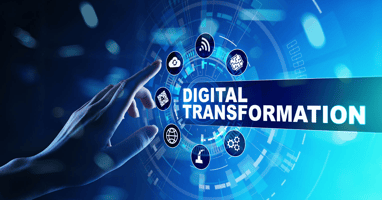Now that you know the different stages of Digital Transformation: Digitization of data and...
Getting Started with Digital Transformation

Since the start of the COVID-19 pandemic, an increased number of people have started to work remotely, leading to an increased adoption of digital transformation.
The shift to a remote workforce has led many companies, perhaps before they planned, to create or update their digital transformation strategy and the digital transformation tools necessary to support that strategy. Discover how to begin your digital transformation strategy and the tools you'll need to get started.
Choose A Digital Transformation Strategy
With various factors such as technological advancements and rapidly changing consumer behavior, many industries are feeling the push to adapt business models and digital solutions. This transformation is more than tools, although the right toolkit is key. To be effective, organizations should start with the strategy and identify what solution actually offers a competitive advantage.
After you have decided on the right business objectives, you may want to use a digital strategy framework to guide the next steps. This framework could include:
- Digital Customer Experience (for example, adding a new digital revenue stream)
- Digital Enterprise (such as digitizing your finance/accounting activities)
- Digital Business (may include developing new digital business models outside your core business)
Your Digital Transformation Toolkit
Your digital transformation toolkit is a collection of software- and web-based tools that simplify work tasks. The aims of using digital transformation tools include increasing productivity, driving innovation, and communicating more effectively.
What You Need in Your Toolkit
Once you have determined your digital strategy, these are the five tools you want to implement.
1. Data Entry Tools
One of the most effective ways to optimize information storage and accessibility is to implement data entry tools. Instantly calculate and develop graphs with information inputted into an Excel spreadsheet.
2. Managed IT Tools
In today's world, a computer may not be necessary to earn revenue, but it is required to build a digital presence and drive sales. Managed IT tools help ensure your website is fully functional and protected from attacks.
3. Cloud-Based Tools
Share and store files privately with cloud-based tools. Cloud services allow you to connect and share information instantly with the entire workforce.
4. Task Automation and Configuration Tools
For advanced workplaces, digital systems automation is accessible through Microsoft PowerShell. With some coding know-how, you can optimize cloud integration and CI/CD and automate Windows tasks.
5. Messenger Tools
Do you have a workforce active around the clock or in different parts of the world? Stay informed and efficient by communicating and sharing files digitally through a messaging platform.
The Ins and Outs of Digitalization Strategy
One current digitalization trend involves combining various tools through fierce competition among global tech companies. Digitalization makes it easier for businesses to store, track, and manage through cross-functionality.
Digital Transformation is an “engine” that collects and uses data as fuel to make smarter investment decisions and drive leadership. Every time you implement a new tool, review who adopts it into their workflows and how it benefits their efforts.
Digitalization may start small in scale, based on your employees' ability and your company's functions. An example of a successful digitalization strategy for one company may be ineffective for another. But by adjusting and adapting to the needs of your workforce, you can create a more effective model in the digital age.
Optimize Your Workforce with Data Networks
Contact Data Networks if you want to streamline your workflow. We can help implement digital transformation tools through data center optimization, cybersecurity protection, and network design.

.png?height=200&name=LinkedIn%202%20(6).png)


.png?height=200&name=LinkedIn%202%20(5).png)